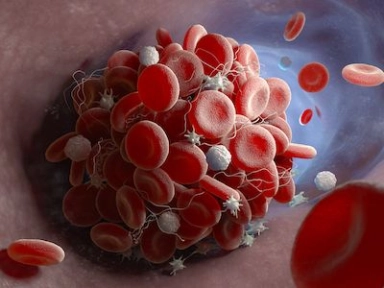Risk for Pulmonary Embolism Continues Beyond 6 Weeks of Surgery
Guidelines recommend postoperative prophylactic anticoagulation for 1-5 weeks.

Key Takeaway
-
The risk for postoperative pulmonary embolism (PE) in patients undergoing surgery is significantly higher during the first 12 weeks of surgery.
-
The risk for PE was more than two-fold high with vascular, hip/knee replacement, fracture surgeries during week 13-18.
-
The risk remained higher but not clinically significant at week 19-25 after gastrointestinal and orthopaedic procedures.
Why This Matters
-
Current guidelines recommend postoperative prophylactic anticoagulation for 1-2 weeks after surgery and for up to 5 weeks after major orthopaedic surgery.
-
The findings suggest that further randomised clinical trials are needed to evaluate whether the duration of postoperative prophylactic anticoagulation should be extended and define the optimal duration of treatment.
Study Design
-
A retrospective case-crossover analysis of 60,703 cancer-free adults (aged, 45-64 years) from the French national inpatient database who underwent surgery and were admitted to hospital with a diagnosis of PE during 2009-2014.
-
The case period immediately preceded the onset of PE and control period was exactly 1 year earlier.
-
Surgical procedures were classified into vascular, gynaecologic, gastrointestinal, knee/hip, fractures or other orthopaedic surgeries.
-
Primary outcome: diagnosis of PE.
-
Funding: None disclosed.
Key Results
-
The risk for postoperative PE was elevated during the first 6 weeks and week 7-12 for all surgical procedures:
-
vascular surgery: OR, 5.24 (95% CI, 3.91-7.01) and 3.15 (95% CI, 2.25-4.41), respectively;
-
gastrointestinal surgery: OR, 5.51 (95% CI, 4.45-6.82) and 2.26 (95% CI, 1.81-2.82), respectively;
-
surgery for fractures: OR, 8.34 (95% CI, 6.07-11.45) and 4.23 (95% CI, 3.01-5.92), respectively;
-
gynaecological surgery: OR, 8.17 (95% CI, 5.19-12.86) and 2.29 (95% CI, 1.39-3.75), respectively;
-
hip/knee replacement: OR, 5.44 (95% CI, 3.86-7.66) and 3.64 (95% CI, 2.66-4.99), respectively and
-
other orthopaedic surgery: OR, 5.46 (95% CI, 4.40-6.78) and 2.82 (95% CI, 2.20-3.61), respectively.
-
-
At week 13-18:
-
more than 2-fold risk for PE was seen with vascular (OR, 2.64; 95% CI, 1.80-3.89), hip/knee replacement (OR, 2.26; 95% CI, 1.53-3.35) and fracture surgeries (OR, 2.39; 95% CI, 1.65-3.46).
-
the risk for PE was also higher with gastrointestinal (OR, 1.57; 95% CI, 1.20-2.04) and other orthopaedic surgeries (OR, 1.31; 95% CI, 1.02-1.69).
-
-
A higher risk for PE was observed at week 19-25 for gastrointestinal (OR, 1.63; 95% CI, 1.25-2.13), hip/knee replacement (OR, 1.75; 95% CI, 1.20-2.55), fracture (OR, 1.66; 95% CI, 1.12-2.45) and other orthopaedic surgeries (OR, 1.47; 95% CI, 1.13-1.91), but this was not clinically significant.
Limitations
-
The precision of conclusions may be limited because both major and minor procedures were evaluated.
-
Patients received systematic postoperative prophylactic anticoagulation in accordance with the current guidelines.
-
Patients with massive PE who died before reaching emergency department were not included.
-
The risk associated with surgery or other components of current practice was not considered.
- Caron A, Depas N, Chazard E, Yelnik C, Jeanpierre E, Paris C, Beuscart JB, Ficheur G. Risk of Pulmonary Embolism More Than 6 Weeks After Surgery Among Cancer-Free Middle-aged Patients. JAMA Surg. 2019 Oct 9 [Epub ahead of print]. doi: 10.1001/jamasurg.2019.3742. PMID: 31596449



